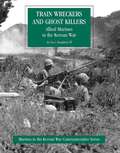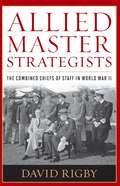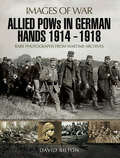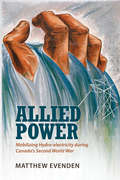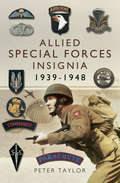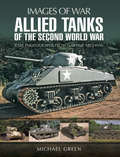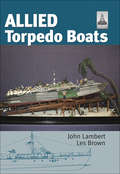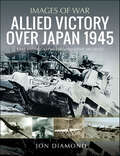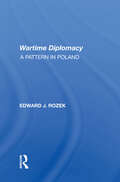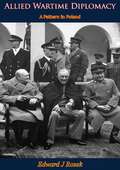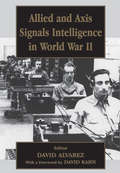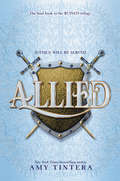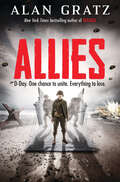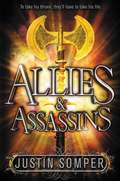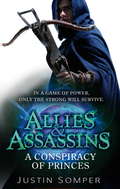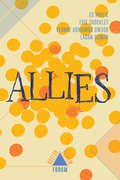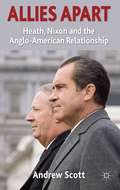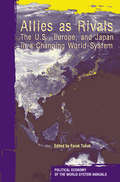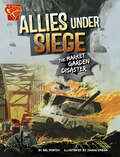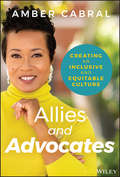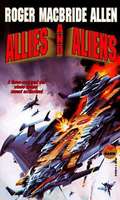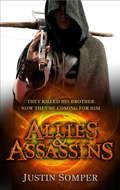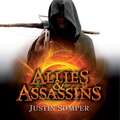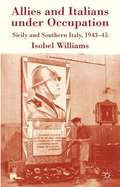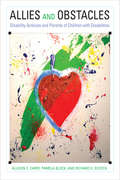- Table View
- List View
Allied Marines In The Korean War: Train Wreckers And Ghost Killers [Illustrated Edition]
by Dr Leo J. Daugherty III[Illustrated with more than 40 maps, photos and diagrams]Command Historian Dr Leo J. Daugherty III reveals the missions, actions and successes of the British and Korean Marines that fought alongside the US Marines in the UN Allied forces during the Korean War."Among the United Nations forces committed to the far-flung battlefield that was Korea, it was the Marine component that stood out in its sacrifice, military skills, and devotion to duty. In Korea, allied Marines, whether American, British, or Korean, demonstrated the versatility, aggressiveness, and readiness that has always been the hallmark on those bearing the title "Marine.""
Allied Master Strategists
by David RigbyCalling the Combined Chiefs of Staff the glue that held the British-American alliance together in World War II, David Rigby describes the vital contributions to Allied victory made by the organization, which drew its members from the U.S. Joint Chiefs of Staff, the British Chiefs of Staff Committee, and the British Joint Staff Mission. Readers get a good understanding of the personalities involved and insights into the relationships between the Chiefs and Allied theater commanders. The role of the Combined Chiefs in economic mobilization and the bitter inter-Allied strategic debates are fully examined. Detailed information is also given about the Casablanca Conference and the Chiefs' often highly contentious meetings in Washington. The book gives the Combined Chiefs what they have long deserved-a book not weighted towards the Americans or the British and not strictly naval, army, or air oriented, but combined in an international as well as an inter-service manner.
Allied POWs in German Hands 1914–1918: Rare Photographs from Wartime Archives (Images of War)
by David BiltonA fully-illustrated account of the dangers, the deaths, and the hardships of the thousands of Allied men who became prisoners of war during World War I. After being forced or making the decision to surrender, the soldier, sailor, or airman was at the mercy of his captors. Here, readers will learn what it felt like to surrender, the hazards involved, and then the often-arduous journey to a prisoner camp in Germany. Not all camps were the same; some were better than others, a situation that could easily change with the replacement of the commandant. But most were poor. Disease was rife and there was little medical care. With the arrival of parcels from home most prisoners could implement their diet, but this was not the case for Russians who received little help and relied on handouts from other prisoners. Barracks were usually cold and there were few blankets and little clothing. Men were abused, starved, denied their basic rights, sent to work in appalling conditions, and some were simply murdered. Escape was a priority for many men, but few made it home. This is the stark, unflinching true story of men who volunteered to fight for their country, only to end up in a war for survival at the mercy of the enemy.
Allied Power
by Matthew EvendenCanada emerged from the Second World War as a hydro-electric superpower. Only the United States generated more hydro power than Canada and only Norway generated more per capita. Allied Power is about how this came to be: the mobilization of Canadian hydro-electricity during the war and the impact of that wartime expansion on Canada's power systems, rivers, and politics.Matthew Evenden argues that the wartime power crisis facilitated an unprecedented expansion of state control over hydro-electric development, boosting the country's generating capacity and making an important material contribution to the Allied war effort at the same time as it exacerbated regional disparities, transformed rivers through dam construction, and changed public attitudes to electricity though power conservation programs.An important contribution to the political, environmental, and economic history of wartime Canada, Allied Power is an innovative examination of a little-known aspect of Canada's Second World War experience.
Allied Special Forces Insignia, 1939–1948: 1939-1948
by Peter TaylorAs early as 1940 political leaders and military commanders responsible for the conduct of the Allied operations relalised that, after a string of disastrous setbacks, national morale could only be restored by taking offensive action against the enemy. With the limited resources available Churchills stirring call to set Europe ablaze called for unconventional solutions and action.From these uncertain beginnings was born a plethora of Allied Special Force units. Inevitably some are household names but others are little known, having had brief and covert existences in far flung parts of the world.rnrnAll, however, had distinctive identities and their proudly worn insignia represent a fascinating and often elusive challenge for militaria collectors. This is due, not just to the scarcity of items in many cases, but to the mystery of their origin; a number of these units were established on an ad hoc and spontaneous basis.Peter Taylors aim in compiling Allied Special Forces Insignia 1939–1948 is to fill a gap in the growing bibliography of militaria collecting. At the same time, Brigadier Bryan Watkins introduction sets in context the growth and development of Allied Special Forces during the global conflict 1939-45.Lavishly illustrated, this work will prove an essential reference work and companion guide for the expert collector and all interested in military history.
Allied Tanks of the Second World War (Images of War)
by Michael GreenExpert author Michael Green has compiled a full inventory of the tanks developed and deployed by the Allied armies during the six year war against Nazi Germany and her Axis partners.There were four categories of tank: Light, Medium, Heavy and Super Heavy. Combat experience proved Light tanks (such as the Stuart and T-26) to be ineffective. Medium tanks (the US M4 series, named Sherman by the British, and Russian T-34) soon dominated with their fire power, protection and mobility.The later stages of the War required the Allies to answer the Axis Panther and Tiger tanks with up-gunned and up-armoured second generation M4s, T-34-85s and the Sherman Firefly. Totally new heavy tanks such as the M-26, Pershing, Soviet KV-1 series and the British Centurion only saw action in the final months.Allied Tanks of the Second World War covers all these categories in detail as well as the few super heavy tanks such as the French Char 2C and the TOG. For an informed and highly illustrated work this book has no comparable rival.
Allied Torpedo Boats: Allied Torpedo Boats (ShipCraft)
by John Lambert Les Brown&“An inspirational/enjoyable book with excellent representations of a wide variety of [Motor Torpedo Boats] by various modelers in a variety of scales.&”—ModelGeek The ShipCraft series provides in-depth information about building and modifying model kits of famous warship types. Lavishly illustrated, each book takes the modeler through a brief history of the subject class, highlighting differences between sisterships and changes in their appearance over their careers. This includes paint schemes and camouflage, featuring color profiles and highly detailed line drawings and scale plans. The modeling section reviews the strengths and weaknesses of available kits, lists commercial accessory sets for super-detailing of the ships, and provides hints on modifying and improving the basic kit. This is followed by an extensive photographic gallery of selected high-quality models in a variety of scales, and the book concludes with a section on research references—books, monographs, large-scale plans and relevant websites. This volume follows the format of the highly successful Flower Class Corvettes where the extent has been doubled to include far more detailed drawings of the many different designs of British MTBs and US PT-boats, including their fittings, sensors and weapons. &“The content is packed with information that makes you want to turn a page, from the history of torpedo boats from 1915-1945, which then goes on to model products, showcase, construction, aftermarket products for scales 1-1200 to 1-100 . . . Not only a reference to torpedo boats, but a wonderful guide to building and getting the best out of a model.&”—AutoModeler
Allied Victory Over Japan 1945 (Images of War)
by Jon Diamond"Jon Diamond is to be commended for his attention to detail, great use of maps and amazing photographs." — IPMS/USA In 1944 with the war in Europe turning in the Allies’ favor, Japan still occupied vast swathes of South East Asia and the Pacific. In Burma, the seemly unstoppable Japanese advance was halted at Kohima and Imphal in June and July 1944. Six months later the advances made by British-led forces enabled the re-opening of the supply routes from India to US forces in China. It was not until Spring 1945 that British-led forces seized first Mandalay and then the port city of Rangoon after a year of grueling fighting. Admiral Nimitz’s and General MacArthur’s forces meanwhile were overcoming fanatical Japanese resistance as they invaded Saipan, Guam, Tinian, Leyte and Luzon in late 1944. Iwo Jima and Okinawa fell to the Allies in early 1945. These successes enabled USAAF Superfortresses to bomb mainland Japan. Late Spring/early Summer 1945 saw the steady recapture of the Northern Solomons and Brunei, Borneo and former Dutch colonies. The Soviets were advancing into Manchuria and Korea. The atomic bomb attacks on Hiroshima and Nagasaki in August 1945 finally forced the Japanese to surrender without the inevitable carnage of an invasion of their mainland. The tumultuous events of the final year of the Second World War in the Far East are brilliantly described here in contemporary well captioned images and succinct text.
Allied Wartime Diplomacy: A Pattern In Poland
by Edward J RozekOriginally published in 1959, this volume is a symposium from Official Government documents, Mikolajczyk's private files and other Polish sources is an indictment of Soviet policy towards Poland and of the Western Allies' leniency towards Stalin.
Allied Wartime Diplomacy: A Pattern in Poland
by Edward J RozekOriginally published in 1959, this volume is a symposium from Official Government documents, Mikolajczyk's private files and other Polish sources is an indictment of Soviet policy towards Poland and of the Western Allies' leniency towards Stalin.-Print ed.“This study of one of the most important and most neglected aspects of American foreign policy leading up to the concluding phases of the war and the peace settlements might have been called, in a spirit of bitterness, “The Betrayal of Poland.”…It is a prime piece of documentation and analysis for all who would probe the brutal reality of Soviet policy, neither a riddle nor an enigma to those with eyes to see.The story it tells is, of course, written to show the London Polish government’s efforts to win and keep Polish freedom. Taken largely from the indicated Polish sources, set in their proper context, this work sketches the historical background and traces Soviet policy with great insight. But these sources...make available in a form not previously accessible to the student and scholar the twisting and turning of both British and American policy. This policy, taken up at the crucial points of 1939 and 1944 especially, was confronted by the dilemma of how to honor the British commitments to Poland without laying down a direct challenge to the declared intentions of the Soviet Union. These commitments included not only those given at the outbreak of the war in 1939 but the assurances given at the time of the invasion of Poland by the Soviet Union in 1941 that Britain would not recognize “any territorial changes which have been effected in Poland since Aug., 1939.” The puppet “Lublin government” of handpicked and Communist-controlled figures was intended, as the Moscow broadcasts flatly declared, to assure that “the London clique will be wiped out.” By being forced into a coalition with the Lublin government, the London government-in-exile was indeed wiped out, and Mikolajczyk barely escaped with his life.”
Allied and Axis Signals Intelligence in World War II (Studies in Intelligence)
by David AlvarezThe importance of codebreaking and signals intelligence in the diplomacy and military operations of World War II is reflected in this study of the cryptanalysts, not only of the US and Britain, but all the Allies. The codebreaking war was a global conflict in which many countries were active. The contributions reveal that, for the Axis as well as the Allies, success in the signals war often depended upon close collaboration among alliance partners.
Allied: Ruined 3 (Ruined #3)
by Amy TinteraIn the final book in the New York Times bestselling Ruined series, the romance of The Selection and the epic stakes of Red Queen come together in a story of revenge, adventure, and unexpected love.Emelina Flores and her sister, Olivia, were determined to bring peace to the people of Ruina. But as the war for liberation raged on, what triumph and freedom meant to Em and Olivia slowly changed. As Olivia’s violence and thirst for vengeance became her only ambition, Em was left to pick up the pieces. But it’s not only Em who is upset by Olivia’s increased violence. Other members of the Ruined army are beginning to see the cracks, and soon a small group of them defects from Olivia’s army and joins Em instead.The two sisters are soon pitted against each other in an epic battle for the kingdom and the future, and only one will win.
Allies
by Alan GratzJune 6, 1944: The Nazis are terrorizing Europe, on their evil quest to conquer the world. The only way to stop them? The biggest, most top-secret operation ever, with the Allied nations coming together to storm German-occupied France. <P><P>Welcome to D-Day.Dee, a young U.S. soldier, is on a boat racing toward the French coast. And Dee -- along with his brothers-in-arms -- is terrified. He feels the weight of World War II on his shoulders. <P><P>But Dee is not alone. Behind enemy lines in France, a girl named Samira works as a spy, trying to sabotage the German army. Meanwhile, paratrooper James leaps from his plane to join a daring midnight raid. And in the thick of battle, Henry, a medic, searches for lives to save. <P><P>In a breathtaking race against time, they all must fight to complete their high-stakes missions. But with betrayals and deadly risks at every turn, can the Allies do what it takes to win? <P><P><b>A New York Times Bestseller</b>
Allies & Assassins (Allies & Assassins #1)
by Justin SomperSixteen-year-old Jared is the newly crowned Prince of All Archenfield, ascending the throne after his older brother's mysterious death. But Jared feels reluctant and unprepared to rule the Princedom and its dangerous and powerful court. Like each Prince of All Archenfield before him, Jared must rely on the Council of Twelve to advise him. But he knows he can just as easily be at their mercy--especially when it appears that one of the Twelve might have orchestrated his brother's untimely death. Propelled by his rage over the loss of his brother and wary of all his advisors, Jared can trust only Asta: a clever, strong-willed girl from the settlements, currently serving as the Physician's apprentice. Asta and Jared take it upon themselves to hunt down his brother's assassin--though the assassin may be hunting them, as well. Murder, betrayal, and intrigue abound in Justin Somper's thrilling YA series debut. Exploring the political machinations of the medieval-esque court and the lives that hang in the balance, Allies & Assassins is a gripping tale of a teen torn between duty and revenge.
Allies & Assassins: Number 2 in series (Allies and Assassins #2)
by Justin SomperIn the epic second book in the ALLIES & ASSASSINS sequence, Prince Jared is under attack from enemies on all sides...In seven days, the princedom of Archenfield will be invaded by its deadly rival - Paddenburg.Prince Jared determines to cross the borders and, in a race against time, recruit what strategic alliances he can.As the Prince and his team rides out, his cousin Axel Blaxland launches his own bid for the throne. Each member of the Council of Twelve falls prey to persuasion and manipulation as dangerous secrets and rivalries begin to emerge. Asta Peck, newest member of the Twelve, finds herself plunged into the dark heart of court politics and conspiracy. Identifying her own allies, she resolves to fight on Prince Jared's behalf until he is able to return home to defend himself.In a game of power, only the strongest will survive.Welcome back to Archenfield. Trust no-one.
Allies (Boston Review Forum)
by Yvonne Adhiambo Owuor Ed Pavlic Ladan Osman Evie ShockleyOriginal poetry, fiction, and cultural criticism explore issues of trust, bridge-building, difference, and betrayal, both political and private.How do we know who is on our side? Is it possible for someone who is not like us to share our hopes? Can links forged by empathy or mutual interest match those created by shared experience? What can we gain from alliances that we cannot achieve on our own?These are difficult question to answer even in intimate settings, and more so in arenas of cultural and political struggle. Through original poetry, fiction, and cultural criticism from both established writers and newcomers, Allies offers unique insights into issues of trust, bridge-building, difference, and betrayal. Drawing on the prophetic power of the imagination to conjure both the possible dangers and life-giving possibilities of alliances—be they political, private (such as marriage), therapeutic, or even aesthetic (between readers and writers, for example)—Allies will be essential reading for our times.Allies is the first publication of Boston Review's newly inaugurated Arts in Society department. A radical revisioning of the magazine's poetry and fiction, the department unites them—along with cultural criticism and belles lettres—into a project that explores how the arts can speak directly to the most pressing political and civic concerns of our age, from growing inequality to racial and gender regimes, a disempowered electorate, and a collapsing natural world.
Allies Apart
by Andrew ScottTo date, the Heath-Nixon years have been widely portrayed as marking a low-point in the history of Anglo-American relations even the end of the 'special relationship'; using a wealth of archival material on both sides of the Atlantic, and examining a range of global developments, Allies Apart offers a fresh interpretation of this pivotal period. "
Allies As Rivals: The U.S., Europe and Japan in a Changing World-system (Political Economy of the World-System Annuals)
by Faruk TabakThis book traces the dynamics of international rivalry from the late 1970s up through the present. Among the members of the dominant North political discord has become prominent recently in debates ranging from the Balkan Wars to the Second Gulf War. Yet a wide array of disputes--launching of global positioning systems to steel imports--have shattered the semblance of unity and cooperation among the members of the North, the triad of Europe, U.S., and east Asia. The book explores the subversive ways in which the configuration of economic networks in east Asia are subtly leaving their mark on the structure of the world-system. Also addressed are the ramifications on the South of this sharpening rivalry and, more importantly, whether this round of imperial rivalry will eventually give way, as previously in history, to new forms of international domination.
Allies Under Siege
by Nel YomtovOn September 17, 1944, Allied forces launched Operation Market Garden. This daring offensive behind enemy lines was intended to bring an early end to the war in Europe. But the mission didn’t go as planned and more than 16,000 Allied soldiers were killed, wounded, or captured. What went wrong to turn this bold plan into a horrible disaster, and what was its impact on the war? Young readers will find out in a dramatic graphic novel that tells the tale of one of World War II’s worst military disasters.
Allies and Advocates: Creating an Inclusive and Equitable Culture
by Amber CabralLearn to create an inclusive environment with this actionable and insightful resource Allies and Advocates: Creating an Inclusive and Equitable Culture delivers a powerful and useful message about inclusion and diversity in everyday life. Author Amber Cabral, a celebrated inclusion strategist, speaker, and writer, shows readers how to move away from discriminatory and unjust behaviors to supporting and building meaningful connections with people across our diverse backgrounds and identities. While some books settle for vague advice and catchphrases, readers of Allies and Advocates will benefit from the book’s: Straightforward style and applicable action items Real-world examples highlighting inclusion best practices Implementable tactics to assist people in seeing how they can help create an inclusive environment Perfect for anyone who works in a professional environment, Allies and Advocates is especially useful for those in middle and upper management and those involved in the training and orientation of employees. If you are looking forward to building a culture of inclusivity at work or in your personal relationships, and want to learn how to use your privilege to be a better ally, Allies and Advocates: Creating an Inclusive and Equitable Culture is a must-have.
Allies and Aliens
by Roger Macbride AllenLieutenants Terrance MacKenzie Larson and Joslyn Marie Cooper Larson had just gotten married and also finished training in the League of Planets Survey Service when their first mission was rudely interrupted. The planet of New Finland had been occupied by invaders, human but of unknown origin, who called themselves the Guardians. The Larsons' new mission was to sneak into the occupied system, avoiding a missile defense that could vaporize any fleet the League could send, and open the way for a liberating counter-strike. All in a day's work. But the situation kept getting more complicated. Even utilizing an experimental matter transmitter that could materialize an army onto the surface of the planet, the Larsons would still somehow have to destroy a warship as large as a city that was on its way from the Guardians' home world. And the defeat of the Guardians occupying New Finland would only be the first -- and easiest -- battle in the war, because the Guardians have made contact with powerful aliens. Anticipating an easy victory, the Guardians are quite unaware that the aliens have their own secret agenda.
Allies and Assassins: Number 1 in series (Allies and Assassins #1)
by Justin SomperThey killed his brother. Now they're coming for him. . .As the second prince of Archenfield, Jared never asked to be more than the spare. But behind the walls of the castle is a dark and dangerous court where murder and intrigue are never far below the surface. Now his older brother is dead. The kingdom is his. And the target is on his back. Can he find the assassin before the assassin finds him?
Allies and Assassins: Number 1 in series (Allies and Assassins #1)
by Justin SomperThey killed his brother. Now they're coming for him. . .As the second prince of Archenfield, Jared never asked to be more than the spare. But behind the walls of the castle is a dark and dangerous court where murder and intrigue are never far below the surface. Now his older brother is dead. The kingdom is his. And the target is on his back. Can he find the assassin before the assassin finds him?
Allies and Italians under Occupation
by Isobel WilliamsUsing original documents, the Allied Occupation of southern Italy, particularly Sicily and Naples, is illustrated by examining crime and unrest by Allied soldiers, deserters, rogue troops and Italian civilians from drunkenness, theft, rape, and murder to riots, demonstrations, black marketeering and prostitution.
Allies and Obstacles: Disability Activism and Parents of Children with Disabilities
by Allison C. Carey Pamela Block Richard ScotchParents of children with disabilities often situate their activism as a means of improving the world for their child. However, some disabled activists perceive parental activism as working against the independence and dignity of people with disabilities. This thorny relationship is at the heart of the groundbreaking Allies and Obstacles. The authors chronicle parents’ path-breaking advocacy in arenas such as the right to education and to liberty via deinstitutionalization as well as how they engaged in legal and political advocacy. Allies and Obstacles provides a macro analysis of parent activism using a social movement perspective to reveal and analyze the complex—and often tense—relationship of parents to disability rights organizations and activism. The authors look at organizational and individual narratives using four case studies that focus on intellectual disability, psychiatric diagnoses, autism, and a broad range of physical disabilities including cerebral palsy and muscular dystrophy. These cases explore the specific ways in which activism developed among parents and people with disabilities, as well as the points of alliance and the key points of contestation. Ultimately, Allies and Obstacles develops new insights into disability activism, policy, and the family.
